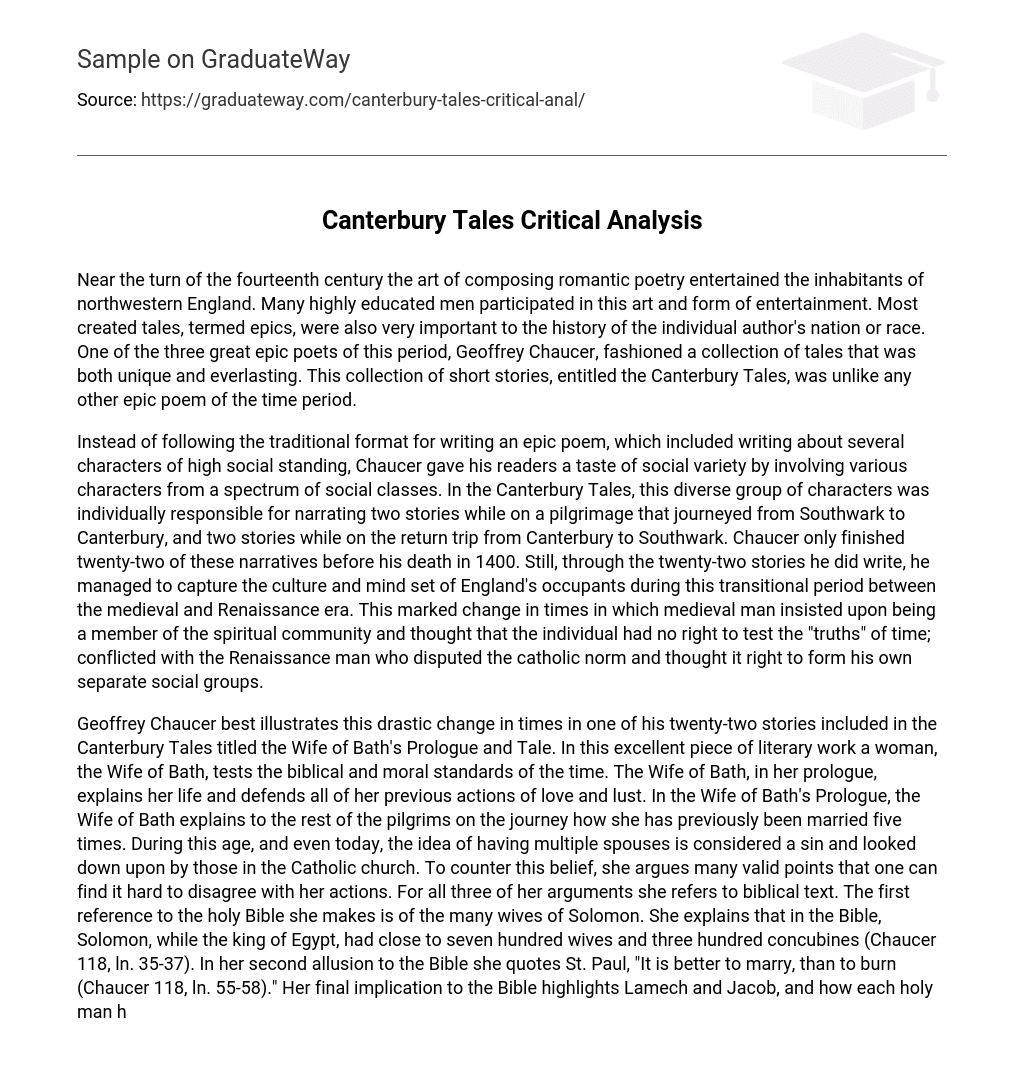During the late 14th century, romantic poetry was a popular form of entertainment in northwestern England. Educated men were actively involved in composing these poems, which often recounted important tales of their nation or race. Geoffrey Chaucer, one of the three prominent epic poets of the era, created a remarkable and timeless collection of short stories known as the Canterbury Tales. This collection stood out from other epic poems of its time.
Instead of adhering to the traditional structure of epic poetry, which focused on characters of high social status, Chaucer provided his readers with a glimpse of social diversity by including individuals from various social classes in The Canterbury Tales. This eclectic group of characters was entrusted with narrating two stories each during a pilgrimage that spanned from Southwark to Canterbury, and another two during the return journey from Canterbury to Southwark. Although Chaucer was only able to complete twenty-two of these narratives before his death in 1400, he effectively captured the culture and mindset of the English people during this transitional period between the medieval and Renaissance eras. This significant shift in time witnessed a contrast between medieval individuals who believed in adhering to the spiritual community and rejecting any sort of challenge to established norms, and Renaissance individuals who questioned Catholicism and saw value in forming their own social circles.
In one of his stories included in the Canterbury Tales, Geoffrey Chaucer depicts a significant change in society. The story is called the Wife of Bath’s Prologue and Tale. In this literary masterpiece, a woman named the Wife of Bath challenges the religious and moral standards of the time. She recounts her life and defends her past actions of love and lust. Throughout her prologue, she explains to her fellow pilgrims that she has been married five times, which was considered sinful in the Catholic church during that era and even today. However, she presents compelling arguments rooted in biblical text to support her actions. Firstly, she refers to Solomon in the Bible, who had around seven hundred wives and three hundred concubines while he was the king of Egypt. Secondly, she quotes St. Paul, who states that it is better to marry than to have sexual desire burn within oneself. Lastly, she mentions Lamech and Jacob from the Bible, stating that these holy men had two wives each. All of these references from the Bible serve as valid justifications in her mind for why the Catholic church should accept multiple marriages.
In Chaucer’s time, it was common to praise women who chose to remain virgins. This belief is also reflected in the Wife of Bath’s Prologue, where she challenges the prevailing ideas of her era. Instead of relying on biblical references, she speaks from personal experience, which she regards as more valuable than authority or scholarly knowledge (Chaucer 117 ln. 1). She acknowledges that the Bible suggests a perfect life is achieved through celibacy, but she and many others are not perfect in all aspects (Chaucer 119 ln. 111-120). This leads her to pose two logical arguments: if all women remained celibate, who would continue humanity by bearing children, and why were sexual organs given to humans if not for both pleasure and procreation (Chaucer 120 ln. 132-134)? These arguments, carefully examined, are logical and true.
After finishing her prologue, the wife of Bath proceeds to tell the tale of a knight who raped a young damsel upon returning to King Arthur’s Court. This action disgusted his entire kingdom, and they demanded justice. King Arthur’s queen begged to judge the knight’s actions, and the king granted her request. She presented the knight with a question – “What is the thing that woman most desire?” – and gave him one year to find the correct answer. Despite questioning countless women, the knight could not find a consensus until he met an old lady with magical powers. She revealed that women desire sovereignty over their partners. The knight relayed this answer to the queen, who agreed with it. As promised, he married the old lady for providing the correct answer. This concept of women attaining sovereignty in relationships was unheard of during this time period. Men typically dominated their spouses, and women had few rights, if any, across various social classes (Chaucer 135-144).Women in the past were expected to unquestioningly obey their husbands. Despite this societal expectation, the Wife of Bath challenges these traditional norms in her tale. Although she briefly mentions the concept of power in her prologue, it is in her tale that she emphasizes it more strongly. Due to this emphasis on power dynamics, the Wife of Bath’s Tale can be seen as a well-crafted plea for the reform of traditional customs instead of a mere entertaining story.
During the transition from the medieval period to the Renaissance, most writings portrayed women as having a limited role in society. However, Chaucer took a different approach in his works, neither criticizing nor supporting women’s roles in his era. Instead, he urges readers to observe the position of women in medieval society and perhaps understand their perspective. Chaucer does not explicitly state whether he sympathizes with the protagonist of the Wife of Bath’s Prologue and Tale, but it is clear that he disagrees with prevailing beliefs about celibacy, marriage, and the moral obligations of women during the Middle Ages. Rather than imposing his own ideas, he presents these moral debates impartially, allowing readers to form their own opinions. It is through this approach that Chaucer addresses these controversial topics, establishing himself as one of the greatest poets in history.





